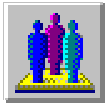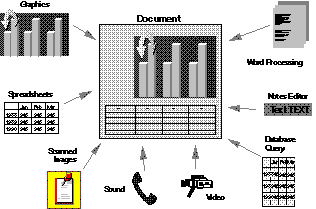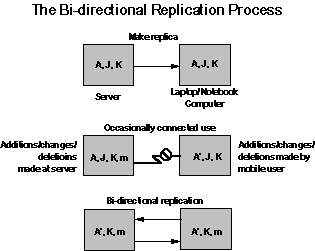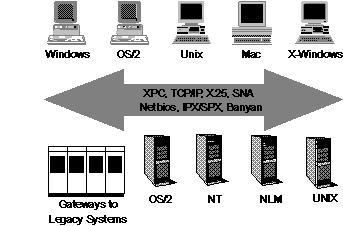
Lotus Notes has defined a new breed of
software called groupware or strategic systems
that enables an organization to realize the full potential of its
networks and its people. Now teams can work together in smarter, faster,
more productive ways, and get more done with fewer resources.
Notes is a client/server environment that allows users (or clients) to communicate securely over a local area network or telecommunications link, with a document residing on a shared computer (or server). Notes combines an application development environment, a document database, and a sophisticated messaging system, giving the user power to create custom applications for improving the quality of everyday business processes in areas like product development, customer service, sales and account management.
In this paper, I'll talk about issues and capabilities regarding Lotus Notes, such as Messaging, Security, Database, Directory Service, Replication, Remote Services and Application Development Environment.
Strategic systems applications that help people work together better to accomplish business goals are communications-centric, use documents as their currency, and help to automate business processes. They also enable an enterprise to create a "corporate memory," a repository of the experience, expertise and unique business knowledge of an organization.
* Strategic systems are designed to support the "extended workgroup" across internal organizational boundaries
* Strategic systems use a different model for communications. They depend on the ability of users to send messages and to share information stored in an easily accessible document repository.
* Strategic systems use a unique information model. The strategic system database manages the relationships among objects via indexed, hierarchical document views, hypertext document links, and object containers.
*E-mail. The current version of Notes provides high-fidelity integration with Lotus cc:Mail through the Lotus Mail Exchange Facility, and allows users to replace the Notes mail service with cc:Mail, or any other VIM-compliant mail system.
*Workflow. In any workflow application there is a need to notify a person or update a form or database based upon the value of a field or the state of a process. Workflow processes not only include the flow of information from person to person, but also from any document to another Notes database or user. Notes messaging includes not only the ability to route documents, but also the ability of one database to look up and update values in other databases.
*Group Calendaring and Scheduling. The Notes message transport can be used with third-party calendaring and scheduling products. Lotus Organizer uses the Notes directory and message transport to provide robust group scheduling.
*Forms Routing. Notes message transport can be used by a forms tool to move data entry and inquiry forms through a predefined route.
The key to security in a distributed system is encryption. The de facto industry standard for access to X.500 directories is the X.509 certificate, which is based on RSA public key encryption technology, recognized as the only encryption system without an exposed point of compromise.
Using cryptography and other security facilities, Lotus Notes provides four levels of security: authentication, access control, field-level privacy and digital signatures.
*Authentication.
*Access Control. Resources under ACL control include servers, individual databases, documents and fields within documents. Notes ACLs include the following levels: Manager, Designer, Editor, Author, Reader and Depositor, each with different read, write, etc. permissions.
*Field-level and Document-level Encryption. Notes database designers can encrypt the sensitive information in the field so that only certain users will be able to read it.
*Digital Signatures. Verification is managed by using digital signatures.

Lotus Notes is a document database: the basic element in a Notes database is an individual document. The structure of a Notes document is typically defined by a form, which contains a number of fields.
Users browse Notes views. When Notes presents a view to the user, it lists field names as columns. Notes views are flexible, employing an outline-like expand-and-collapse metaphor, linkages to and from children and parents.
Notes documents may include:
*Rich Text/Multimedia. This includes tabular data, formatted text, graphics, and linked or embedded objects, as well as multimedia objects such as scanned images and faxes, voice/sound and video.

*Full Text Search. Lotus Notes incorporates a full text search engine to allow users to index and search Notes documents based on user queries. Notes displays those documents fitting the search criteria, sorted by relevance, or sorted in a user specified order. Notes' optical character recognition reads data captured in images and stores it in Notes fields, making it available for full text search.
*Version Control. Lotus Notes provides document versioning capabilities in order to track multiple changes made to a single Notes document by different users.
Notes contains a single directory, the Notes Name & Address Book. The Name & Address Book manages all resource directory information, from individual user addresses for mail to connection records defining how and when replication occurs throughout the network. The Notes Name & Address Book allows Notes administrators to manage user information, database information, and server information such as replication schedules through a single, integrated directory.
A groupware platform makes use of replication technology to allow a remote to make a "copy" of a database and store it on a local server. replication allows workgroups to keep their information synchronized across geographically dispersed sites. Groupware applications do not require the referential integrity and two-phase commit of transaction processing systems.
Notes allows bi-directional update, client, selective and background replication.

Users connect Notes clients and servers to the Internet using TCP/IP support provided in Notes via LAN connections, SLIP (Serial Line Internet Protocol), or PPP (Point-to-Point Protocol). Notes manages authentication and encryption, making the Internet a secure alternative for worldwide Notes connectivity.
Notes today also supports the most popular usage of the Internet: electronic mail.
In the future, Lotus will offer facilities to automate the publication of Notes documents on the Internet's WorldWide Web, and to manage the integration of various Internet information services with Notes document databases.
AT&T Network Notes will provide customers with a secure, scalable infrastructure that includes Notes database servers and the AT&T network, which will allow them to connect users within an organization as well as with other Notes users such as business partners, suppliers and customers. AT&T Network Notes servers will be deployed on AT&T's Interspan Frame Relay Service to support dial-up, dedicated and mobile access from LANs and personal computers.
AT&T Network Notes will provide Notes users with five sets of benefits.
*Local Call Access to Global Connectivity. Using AT&T Network Notes, a person can make a local call from a Notes client and connect to a Notes server in a distant location. AT&T's wide area network will handle the necessary client-to-server connection, relieving the user of the burden of having to identify local servers or making a long distance or international telephone call.
*Network Bridging. AT&T Network Notes reduces the effort required to set up and manage a wide area network.
*Server Management and Support. AT&T will assume the management of Notes servers for companies that do not wish to expend the human and capital resources required to manage a large-scale server implementation.
*Extended Enterprise. Notes provides an organization with the ability to create, share, track and manage information as it flows through a business process. AT&T Network Notes will allow an organization to make its business process applications available on a secure public server, accessible by business partners, suppliers and customers.
*Electronic Business Commerce. AT&T Network Notes provides businesses with a reliable, secure platform on which to enter the new world of electronic commerce. Business customers will be able to make requests for proposals, order equipment, supplies and services, sign contracts and transfer funds using their familiar desktop environment.
Notes allows users to get access to that information from the road, that is, to "pull" it from the server to their mobile client computer. In order to pull this information, Notes mobile users simply initiate communication with a Notes server using a telephone line. Replication technology provides mobile users with the ability to pull information to expedite the flow of communication through workgroups when on the road, provide real-time information to customers and business partners, ensure that the proper information needed to complete a contract or purchase order is available, and send messages from anywhere.

The Lotus Notes Pager Gateway for SkyTel puts mobile professionals in control of the information they need, without having to tell anyone how to reach his or her pager. Instead, the Notes Pager Gateway for SkyTel uses standard Notes background macros to customize a user's Notes mail file to filter mail messages based on priority, sender, subject, or body text, and forward only selected messages to the SkyWord alphanumeric receiver. The gateway can also be used to "page-enable" any Notes database.
A messaging and/or groupware system designed to accommodate many organizations' existing server and network operating systems obviates the need to impose a multiple-enterprise computing standard.
A key to the power of Lotus Notes in today's heterogeneous corporate systems environments is its extensive multiple platform support. All clients, regardless of the platform, can access all servers, exchange information, send and receive e-mail, and participate in the full range of Notes services.

Notes network protocol support includes NetWare, Banyan VINES TCP/IP, SPX, X.PC, AppleTalk and Netbios/Netbeui.
The Notes platform includes an integrated development environment, providing rich tools to developers of varying expertise.
The Notes development environment includes several layers.
*Basic development facilities: forms, views, templates.
*Advanced programming facilities: formulas, macros, data dictionary.
*Extensions to the Notes development environment: database integration, desktop application integration, Notes-specific application development tools, and the Notes API.
Lotus Forms is a development tool designed for creating and implementing forms automation across an enterprise. Developers use Lotus Forms to create a form template or a set of related templates for a specific task, giving users and managers a structured, graphical means with which to view, organize and track business process information. There are four key aspects to Lotus Forms: an intuitive graphical development environment, extensive database access, programmability through LotusScript and robust workflow support.
*Graphical Development Environment.
*Database Access
*Programmability
*Workflow Support
Integration products and technologies that application developers use to leverage Notes and RDBMSs include:
*Access to DBMSs from Notes.
*Access to Notes from ODBC-compliant Products.
*Background/Agent Migration.
*API-Level Integration.
*Import/Export Facility.
Notes/FX (Field Exchange) is a facility built on top of OLE to allow developers to publish desktop application object information and content as Notes fields which appear within Notes views. Notes/FX also coordinates information that crosses applications. Because the documents will share common information, developers can use Notes/FX to capture the information entered into one desktop editor and publish it in another editor, saving the user effort and ensuring accuracy and completeness of the finished result.
Lotus Notes ViP (Visual Programmer) is a visual programming environment specifically designed for Notes developers. It contains a complete set of tools within the programming environment, including a debugger, a script editor, and toolbox containing development objects. Its ability to visually prototype a GUI lends itself to rapid application development.
Notes ViP enhances Notes development functionality in a variety of key areas:
*Query and update of heterogeneous databases.
*Programmability through LotusScript.
*Reporting and charting
*Sophisticated GUI creation
A unique capability of Notes ViP is a rapid application development technology called Visual Linking. Visual Linking allows a developer to create applications by "sketching" or "drawing" the relationships between parts of the application. Each Visual Link encapsulates behaviors and events that speed the development of client/server applications.
Phone Notes makes it possible to extend Notes applications to non-Notes users, and allows Notes users who do not have convenient access to a PC to connect to Notes from a ubiquitous client. Moreover, information captured over a touch-tone telephone can be stored in a Notes document, which then uses the same integral Notes services as any other document. That is, voice messages can be replicated across a distributed workgroup and can become essential components of workflow applications.
Phone Notes is packaged with a set of five sample applications Sales Support Faxback, Customer Service Help Desk, Human Resource Benefits Selection, Notes Mail by Phone and E-mail Page Summary that developers can use immediately or customize.
*LotusScript, Notes API, Development Facilities, Advanced Programming Tools, Macros, Design Templates, Lotus Notes HiTest Tools for Visual Basic, Notes Express, Notes Desktop, Third-Party Development Tools
Lotus Notes continues to set the standard for the rapidly growing groupware market. Since its introduction as the first client-server groupware platform, Notes has established a large and growing base of more than 1 million users, and generated an expanding industry of Notes-based products and services to serve those customers. While other companies rush into the groupware area, none provide the comprehensive, integrated groupware features and application development environment available with Notes.

Lotus Notes is unique. It can be customized specifically to address high-impact business processes which prior to Notes were impractical to automate. Notes allows people to track, share, and organize information in ways never before possible even if they are only occasionally connected to a network. Notes exploits the potential of an organization's existing PCs and workstations to deliver business results.
Lotus has effectively implemented a multiplatform, open systems strategy that makes Notes available across all the leading industry platforms, operating systems, and networks. Lotus has extended Notes so that it can be accessed through the public telephone network, making it possible for organizations to project the power of Notes beyond their corporate network, embracing customers, suppliers, and other external partners.
*This research is based on a Notes White Paper on the Lotus Notes Home Page.
Modified: November 27, 1995
Feedback: Francis Chan
(fchan@ic.eecs.berkeley.edu)